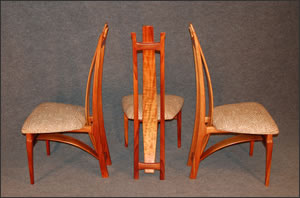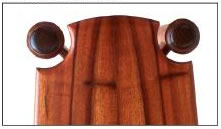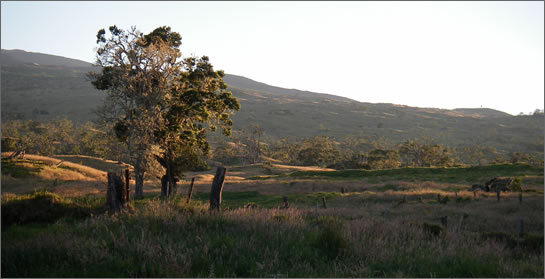It’s easy to see why Koa artisans fall under the spell of their favorite wood. Koa has a quality known as “chatoyancy,” which means it can shimmer like a cat’s-eye gemstone. As a fine piece is viewed from different perspectives, the glistening surface patterns appear to shift and change, suggesting depth, warmth, and liveliness. “It’s the most beautiful wood in the world,” says Kaua‘i craftsman Frank Pullano as he lightly rubs his palm over his latest artwork. “It’s mesmerizing.”

Pullano’s koa creations include desks, chests, benches, paddles,
mammoth entertainment centers, and elaborate custom artworks, much of
it crafted for Mainland visitors who have seen and heard of his work.
In the 2006 wood show, he won the People’s Choice award for a credenza
he calls “Light My Fire.”
The show’s main coordinator, Mariane Yasuda, also talks about wood as if it were magical. An artisan whose wares were featured on HGTV in 2003, she has crafted more than 75 beds and hundreds of other pieces of furniture from koa and other indigenous Hawaiian woods.
Shaun Fleming, one of Hawai‘i’s few female koa artisans, spent several years harvesting her own wood from a small Maui grove planted in the early 1930s by her great uncle. She and her sons performed all the cutting, milling and air drying. Nearing the end of her supply, she will now get her wood from a Big Island mill.
The show’s main coordinator, Mariane Yasuda, also talks about wood as if it were magical. An artisan whose wares were featured on HGTV in 2003, she has crafted more than 75 beds and hundreds of other pieces of furniture from koa and other indigenous Hawaiian woods.
Shaun Fleming, one of Hawai‘i’s few female koa artisans, spent several years harvesting her own wood from a small Maui grove planted in the early 1930s by her great uncle. She and her sons performed all the cutting, milling and air drying. Nearing the end of her supply, she will now get her wood from a Big Island mill.

“About 80 percent of my work is koa,” says Fleming, “because that’s
where the demand is. I love working with koa even though it’s a
difficult material to match up, but it has a depth to it that I haven’t
seen in any other wood. It just radiates beauty.”
Koa was plentiful and cheap many years ago, but “These days, it’s expensive and scarce, especially the deep red koa you get in high elevations on the Big Island,” says 27-year koa craftsman Tom Kaufman. Winner of a Blue Ribbon award at the 2006 show for a pirate’s chest, he is perhaps best known in the field for the boat interior that he created for Julie Andrews.
“As expensive as koa is today, there are people who will pay the price,” says Alan Wilkinson, owner of Wilkinson Koa Furniture on O‘ahu. “My client base is smaller, but the price for what they want is much higher than it was in the early days. A four-poster bed can go for as much as $30,000.”
Still, the appreciative clientele for Hawaiian koa furnishings has always included the highest of the high-end. Some years back, one of Wilkinson’s orders was described as a “high-chair for a little prince” by the gentleman who commissioned the work. When Wilkinson delivered the finished product -- amidst a battery of cameras and flashbulbs -- he learned the high-chair was for Princess Diana’s then-unborn son, Prince William.
High demand and scarce supply are not the only reasons why fine koa furniture can be costly. Precision and artistry are also crucial, and many of these craftspeople have been pursuing their art for decades. Wilkinson, who makes his own veneer, says it can take a full day or more to start with a piece of koa six inches thick, ten inches wide, and eight feet long to turn out 1/16th-inch veneer for table tops, edges and chairbacks.
Comparable craftsmanship is seen in Fleming’s pieces, featuring a delicate process called marqueterie in which elaborate patterns are formed with the insertion of other materials such as shell, ivory, or other woods. Two pieces featured on her website (www.woodentouches.com) highlight this technique: a koa cabinet with mango inlay, and a tall bookcase blending koa, milo, mango and pheasant wood inlays.

Master artisans such as Tai Lake embrace a philosophy that combines beauty, form, and function to make each piece of furniture a work of art. This architectural woodworker’s extensive studies included a stint at Buckminster Fuller’s design department at Southern Illinois University. Today, working with his sons Jonah and Noah, Lake often visits a clients' home to see where the commissioned piece will be placed, to ensure harmony and balance between furniture and setting. He also mills wood on-site to match specific artistic objectives. "I see that tree when it first opens up,” he says, “and I can often visualize a piece while it is still in the log. There may be only one perfect tabletop in an entire tree.”
Lake’s work includes architecturally inspired tables, chairs, and desks as well as free-flowing forms that are inspired by the material itself (www.tailake.net). "All the lines in my pieces harmonize," he explains. "The components are balanced, and everything is proportional and scaled."
Hawai‘i’s entire community of koa craftsmen, as well as their materials suppliers, are keenly aware that stocks of their favorite wood must be replenished. Many woodworkers and mill owners are dedicated to protecting and renewing this cherished natural resource. Lake, for example, practices reforestation as well as strategic land management of invasive plants and animals that threaten koa. “The koa wood that I use comes from a forestry project that I manage in Kona,” Lake explains. “Our plan uses the profits from lumber salvaged from dying and downed trees to fence the land and allow the re-growth of the forest. My involvement with forest management and the actual harvesting and sawing of my materials has given me access to a truly great supply of woods unique to Hawai‘i.”

Sawmill owner Jay Warner and his crew utilize 1,600 acres of Kona’s Parker Ranch for forestry as preservationist-contractors under a timber license agreement. Warner explains that every effort is made to harvest trees that have come to the end of their lifecycle anyway. “When a koa tree gets to be 60 feet high,” he says, “the root system begins to rot and the tree is like a sail. Most of them die and blow over in the wind. A lot of them are buried deep below the soil but they’re still good. We salvage dead or dying trees, or mine for trees that are buried.”
Alan Wilkinson’s plan for contributing to the future supply of koa is even more personal, and perhaps even more quintessentially Hawaiian. “When I check out,” he chuckles, “my ashes will be scattered around the trees and my spirit will grow with them. It’s the ultimate regeneration.”
With so many koa artisans and suppliers acting on this dedicated spirit of ecological harmony, the magic of koa woodworking appears likely to remain a thriving Hawaiian artform for many years to come.
Koa was plentiful and cheap many years ago, but “These days, it’s expensive and scarce, especially the deep red koa you get in high elevations on the Big Island,” says 27-year koa craftsman Tom Kaufman. Winner of a Blue Ribbon award at the 2006 show for a pirate’s chest, he is perhaps best known in the field for the boat interior that he created for Julie Andrews.
“As expensive as koa is today, there are people who will pay the price,” says Alan Wilkinson, owner of Wilkinson Koa Furniture on O‘ahu. “My client base is smaller, but the price for what they want is much higher than it was in the early days. A four-poster bed can go for as much as $30,000.”
Still, the appreciative clientele for Hawaiian koa furnishings has always included the highest of the high-end. Some years back, one of Wilkinson’s orders was described as a “high-chair for a little prince” by the gentleman who commissioned the work. When Wilkinson delivered the finished product -- amidst a battery of cameras and flashbulbs -- he learned the high-chair was for Princess Diana’s then-unborn son, Prince William.
High demand and scarce supply are not the only reasons why fine koa furniture can be costly. Precision and artistry are also crucial, and many of these craftspeople have been pursuing their art for decades. Wilkinson, who makes his own veneer, says it can take a full day or more to start with a piece of koa six inches thick, ten inches wide, and eight feet long to turn out 1/16th-inch veneer for table tops, edges and chairbacks.
Comparable craftsmanship is seen in Fleming’s pieces, featuring a delicate process called marqueterie in which elaborate patterns are formed with the insertion of other materials such as shell, ivory, or other woods. Two pieces featured on her website (www.woodentouches.com) highlight this technique: a koa cabinet with mango inlay, and a tall bookcase blending koa, milo, mango and pheasant wood inlays.

Master artisans such as Tai Lake embrace a philosophy that combines beauty, form, and function to make each piece of furniture a work of art. This architectural woodworker’s extensive studies included a stint at Buckminster Fuller’s design department at Southern Illinois University. Today, working with his sons Jonah and Noah, Lake often visits a clients' home to see where the commissioned piece will be placed, to ensure harmony and balance between furniture and setting. He also mills wood on-site to match specific artistic objectives. "I see that tree when it first opens up,” he says, “and I can often visualize a piece while it is still in the log. There may be only one perfect tabletop in an entire tree.”
Lake’s work includes architecturally inspired tables, chairs, and desks as well as free-flowing forms that are inspired by the material itself (www.tailake.net). "All the lines in my pieces harmonize," he explains. "The components are balanced, and everything is proportional and scaled."
Hawai‘i’s entire community of koa craftsmen, as well as their materials suppliers, are keenly aware that stocks of their favorite wood must be replenished. Many woodworkers and mill owners are dedicated to protecting and renewing this cherished natural resource. Lake, for example, practices reforestation as well as strategic land management of invasive plants and animals that threaten koa. “The koa wood that I use comes from a forestry project that I manage in Kona,” Lake explains. “Our plan uses the profits from lumber salvaged from dying and downed trees to fence the land and allow the re-growth of the forest. My involvement with forest management and the actual harvesting and sawing of my materials has given me access to a truly great supply of woods unique to Hawai‘i.”

Sawmill owner Jay Warner and his crew utilize 1,600 acres of Kona’s Parker Ranch for forestry as preservationist-contractors under a timber license agreement. Warner explains that every effort is made to harvest trees that have come to the end of their lifecycle anyway. “When a koa tree gets to be 60 feet high,” he says, “the root system begins to rot and the tree is like a sail. Most of them die and blow over in the wind. A lot of them are buried deep below the soil but they’re still good. We salvage dead or dying trees, or mine for trees that are buried.”
Alan Wilkinson’s plan for contributing to the future supply of koa is even more personal, and perhaps even more quintessentially Hawaiian. “When I check out,” he chuckles, “my ashes will be scattered around the trees and my spirit will grow with them. It’s the ultimate regeneration.”
With so many koa artisans and suppliers acting on this dedicated spirit of ecological harmony, the magic of koa woodworking appears likely to remain a thriving Hawaiian artform for many years to come.



![A Tranquil Jungle House That Incorporates Japanese Ethos [Video]](https://asean2.ainewslabs.com/images/22/08/b-2ennetkmmnn_t.jpg)









